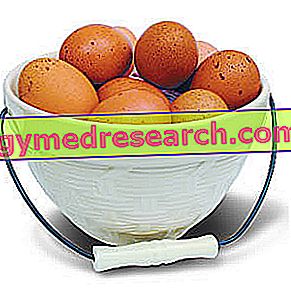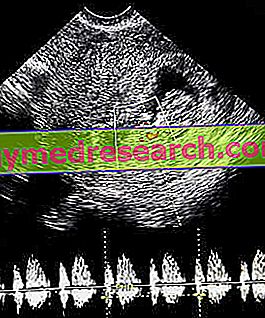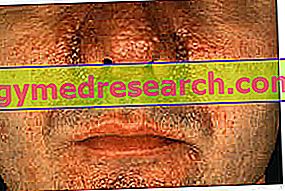See also: eggs and cholesterol and fresh eggs
Some consider them the most nutritious food in the world, others fear them for their cholesterol content, others still appreciate their versatility in the kitchen ... maybe because of the richness in proteins, good fats, iron, zinc and vitamins, but any relationship we bind ourselves to them, we can certainly not deny their universal importance in human nutrition.
With an average weight of about 50 grams, the hen's egg can be roughly divided into three parts: the outer shell, consisting mainly of calcium, is thin, fragile and porous, therefore capable of permitting gas exchange with the environment; the egg white or egg white, more internal, is separated from the shell by a double membrane, one of which adheres perfectly to it while the second is more adherent to the albumen; finally, more internally, we find the yolk, separated from the album by another membrane which at the ends forms two species of cords, called chalazae, which allow it to remain perfectly in the center of the egg.

After the deposition, with the lowering of the temperature (which passes from the body of the hen to the environmental one), the volume of the egg white decreases; this causes the two membranes that separate it from the shell to detach at the bottom, giving rise to a small dividing interspace which is called an air chamber. Due to water leaks, the width of this space, which is generally 3mm, increases in size as the days go by and is therefore a widely used index to evaluate the freshness of the egg.
Nutritional values
| Whole egg | water | Protein | Lipids | carbohydrates | Minerals | Kcal | |
| Shell | 8, 5-10, 5 | 1 | 4 | - | - | 95 | - |
| Egg white | 60-66 | 87-89 | 10.7 | - | 0.4-0.5 | 0.5-0.7 | 43 |
| Yolk | 24-30 | 46.5 to 48.5 | 15.8 | 29.1 | 0.15-0.25 | 1.1 to 1.6 | 325 |
| Egg white + Yolk | 90-92 | 74-76 | 12.4 | 8.7 | 0.3-0.4 | 0, 8-1 | 128 |
Insights
The egg yolk The egg white Functional properties of the egg Egg preservation Labeling Fresh eggs Eggs and cholesterol Easter eggs Egg eggsThe egg yolk
The yolk can be considered as a dispersion of lipoprotein globules in an aqueous or plasma mass; it is therefore rich in proteins, lipids, but also in lecithins; its composition is not homogeneous but consists of more or less dense layers.
Proteins: α and Β lipovitelline (they are the most abundant lipoproteins in the egg), fosvitina (it is the protein that binds iron) and livetine (soluble proteins present in the plasma fraction of the yolk).
Lipids : unlike most foods, only 65% of egg lipids are triglycerides (compared to 98% of other foods). The egg is indeed very rich in lecithins and in general in phospholipids (30%), which give it noteworthy health and functional properties (the emulsifying power allows, for example, the preparation of mayonnaise). Another characteristic of eggs is that their fats, although of animal origin, consist mainly of monounsaturated and polyunsaturated (those considered beneficial for the organism).
Cholesterol : 5% (about 200 mg / egg): it is certainly a high quantity, just think that the daily requirement is estimated at 300 mg and that therefore two eggs would be enough to breach this limit. It must be said, however, that the high lecithin content favors the reverse transport of cholesterol (from arteries to the liver) enhancing the activity of HDL (the so-called good cholesterol). The lecithins, which as we said allow an excellent emulsification of lipids, also favor brain performance and the digestive processes of the food: two soft-boiled eggs leave the stomach in two hours, against the three necessary for a portion of meat; digestion times are in fact proportional to the amount of fat used and increase, even more, if the condiments are brought to high temperatures (as in the case of fried eggs). Eggnog and omelettes are also not recommended for those suffering from gallstones (the so-called liver calculi), since the large quantity of lipids stimulates the contraction of the gall bladder and could therefore cause painful colic. Finally, it should be noted that eggs now contain less cholesterol than in the past, thanks to a constant selection of egg-laying breeds.
How to cook eggs
Hard-boiled eggs
Poached eggs
Marinated egg
Scrambled eggs with alcohol
Soft-boiled egg cooked in a dishwasher
Smart omelette with egg whites
Ox Eye Eggs
Other recipes with eggs
Plant alternatives to eggs
Ox Eye Egg
X Problems with video playback? Reload from YouTube Go to Video Page Go to Video Recipes Section Watch the video on youtube



